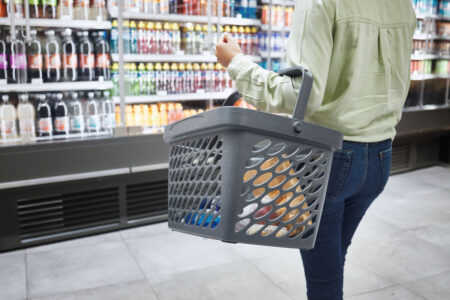Share On Social!
How did smallish Berkeley, Calif., become the nation’s first city to pass a sugary drink tax in 2014, after many other cities had failed?
People power!
Local health advocates like Xavier Morales had long supported a tax on sugary drinks, believing the higher price would discourage consumption.
Research studies indicate that such a decrease in consumption could potentially reduce obesity and diabetes rates, especially for Latino kids. Because Latino children are heavily targeted by sugary drink and junk food advertisements, this issue was especially important to Berkeley’s 11% Latino community.
In the end, it took passionate advocates, a well-organized campaign for a sugary drink tax, and national attention to eventually bring sweet victory for public health advocates in Berkeley.
Why Sugary Drinks Are a Health Issue
Factors that would eventually lead to the proposal of a sugary drink tax had been bubbling for a while in Berkeley, a city of about 116,000 near the San Francisco Bay area.
One of these factors was the termination of a U.S. Department of Agriculture funding source that resulted in the cancellation of cooking and gardening programs at local elementary schools.
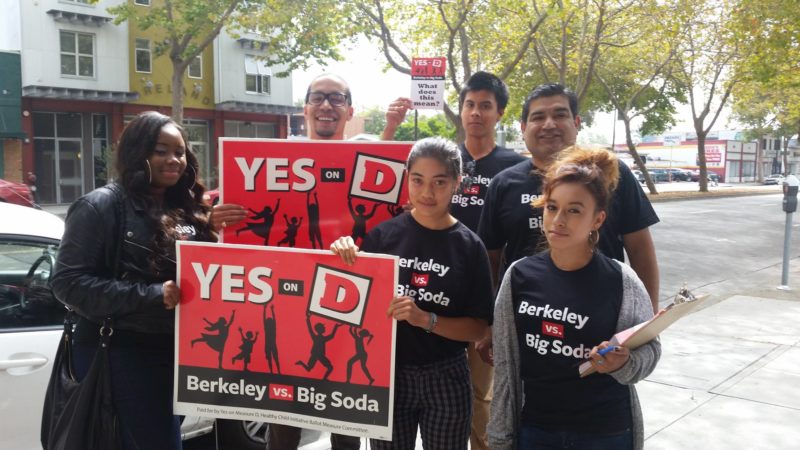
The community wasn’t happy.
“People were trying to figure out ways to get revenue to support that again,” said Dr. Xavier Morales, the Executive Director of Latino Coalition for a Healthy California.
That effort morphed into a broader community look at Latino health issues.
Consuming too many sugary drinks, Morales said, is a contributor to many health issues that disproportionately impact Latinos, such as diabetes, heart disease, and stroke.
Sugary drink marketing to kids was another cause for concern, said Sara Soka, the campaign manager behind what would become the Berkeley vs. Big Soda sugary drink tax campaign. She said that TV, Internet, and social media/mobile ads promoting sugary drinks are frequently targeting kids, especially Blacks and Latinos.
“With all of the social media now, we can’t see when they are directly marketing to kids,” Morales added.
Morales thought, how could they reduce sugary drink consumption locally?
He and other health advocates believed adding a small tax to sugary drinks had potential to both reduce consumption and disease—and increase healthy programs in Berkeley.
“We wanted to disincentivize the consumption of sugar-sweetened beverages, but at the same time we wanted to generate resources so we could go out and support school-based and community-based efforts to prevent chronic diseases,” Morales said.
In February 2014, they formed Berkeley vs. Big Soda—a broad coalition of community groups, academic researchers, medical professional and parents—to propose a local one-center-per-ounce tax on sugary drinks.
The coalition started to learn all they could from failed attempts to pass drink taxes, like the attempt in Richmond, a town nearby. Other jurisdictions that have attempted to pass a soda tax include El Monte, Calif., Telluride, Colo., Illinois and Vermont. They asked advocates in other cities, “If you had to do this all over again, what would you do?”
“We were taking that information and building a really strong coalition of leaders,” Morales said.
Mobilizing Support for a Sugary Drink Tax
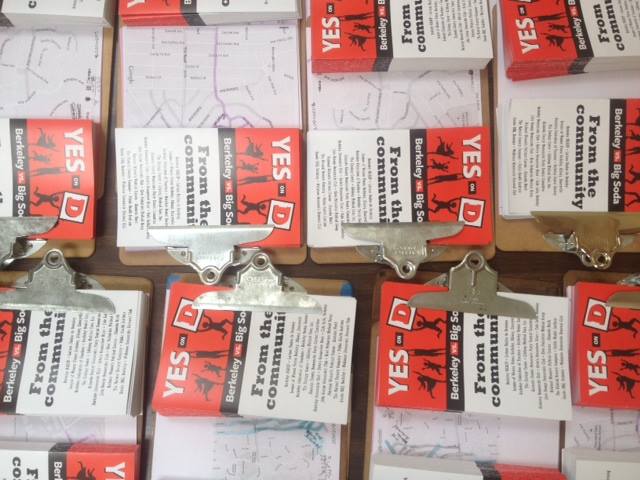 The Berkeley vs. Big Soda coalition believed that, despite the failure of similar measures in other towns, residents of Berkeley would put the health of their children first.
The Berkeley vs. Big Soda coalition believed that, despite the failure of similar measures in other towns, residents of Berkeley would put the health of their children first.
So they brought the idea of a sugary drink tax to the Berkeley City Council in early February 2014.
“Many different groups spoke on behalf of the measure,” Soka said.
The council agreed to add the sugary drink tax to a community poll assessing possible ballot measures for the November 2014 election.
The community poll revealed that a tax on sugary drinks would have enough support to warrant a vote, and on July 1, 2014 the council approved adding the measure, officially known as Measure D, to its November 2014 ballot.
Advocates for Measure D knew from other towns’ failed sugary drink measures that the beverage industry would fight any such tax. The industry spent more than $2.3 million to fight a soda tax in Richmond, and was prepared to do the same in Berkeley.
Measure D supporters knew they needed to get their message out and gain the trust of residents.
So health professionals, academics, church officials, and City Council members who supported Measure D began reaching out to their neighbors.
Respected members of the Black and Latino community also began speaking up. They held community meetings, where leaders would inform about the health hazards of sugary drinks. Soka said it was important for communities to hear trusted leaders and friends explain why they supported Measure D. Advocates also participated in canvasing.
“We were all going door to door talking to our neighbors,” and got the word out through earned media stories, like articles in the local paper and local TV news, Morales said.
“The campaign was widely covered in Berkeley and even throughout the country,” Soka said.
The more press the campaign got, the more chances they had to convey their message and argue for the measure, Soka said.
Before the measure could go to the voters, a few technicalities had to be addressed to fit into California tax code.
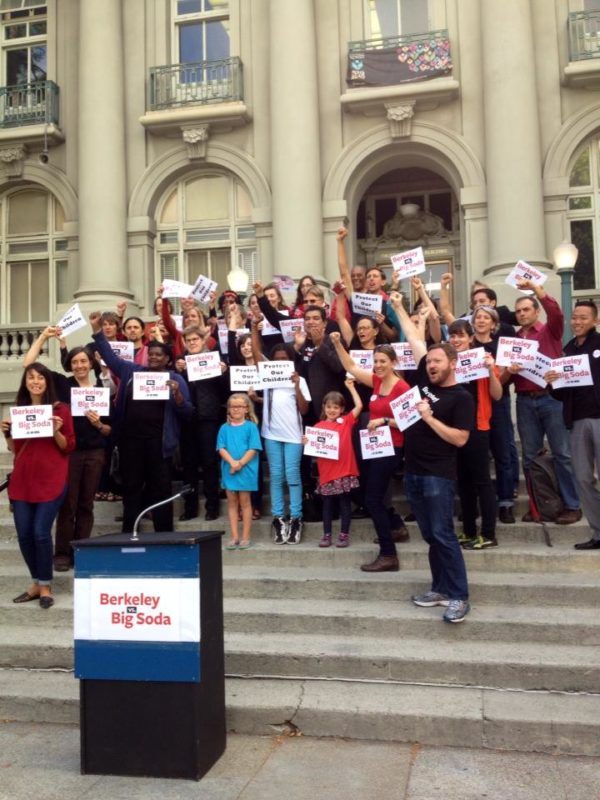 Specific fund taxes designate the tax money for a specific purpose and have a higher voting threshold, two-thirds must vote in favor. General fund taxes place the taxes raised into a general fund with no specific allocation and requires only 50% of the vote.
Specific fund taxes designate the tax money for a specific purpose and have a higher voting threshold, two-thirds must vote in favor. General fund taxes place the taxes raised into a general fund with no specific allocation and requires only 50% of the vote.
The Berkeley City Council decided to designate the proposed soda tax as a general fund tax.
However, Morales said that didn’t mean the money raised would just sit somewhere, unused.
“A panel of experts would be convened to spend the revenue on chronic disease prevention and education,” he said.
Of course, the beverage industry used this as one of their arguments, claiming that the money raised wouldn’t be spent in the public’s interest. This made it even more critical that the implementation of the policy, if approved by voters, followed through on bringing together health experts to spend the money wisely, Morales said.
Critics of the measure also argued: the tax was regressive (hurt underserved populations more), government shouldn’t tell individuals what they should and shouldn’t do, other foods contribute to obesity (why pick on soda and not milkshakes?), and the measure had too many loopholes.
But soda tax advocates wouldn’t let these arguments go unanswered.
The Frequently Asked Question page on the Berkeley vs. Big Soda website addressed many of the questions residents might have about the tax, and quell fears being perpetuated by the beverage industry, Soka said.
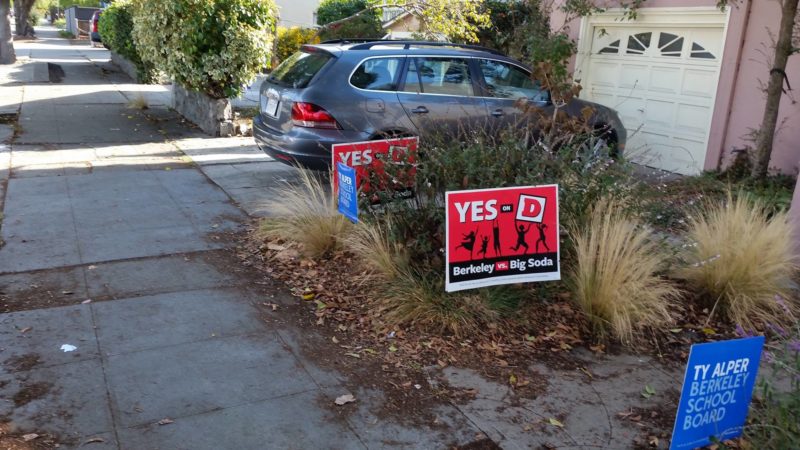 “Our argument was that nobody is going to Costco and buying a suitcase of milkshakes, but they are going to Costco and buying a suitcase of soda,” Morales said. “The industry’s tactics are always to go in and drive wedges between people and communities of color.”
“Our argument was that nobody is going to Costco and buying a suitcase of milkshakes, but they are going to Costco and buying a suitcase of soda,” Morales said. “The industry’s tactics are always to go in and drive wedges between people and communities of color.”
In August 2014, a potential roadblock appeared: a lawsuit. Two Berkeley residents asked the court to change the phrases “high-calorie, sugary drinks” and “high calorie, low nutrition products” to “sugar-sweetened beverages” in ballot materials. They argued that the language was biased in favor of the tax and state law requires ballot materials to be impartial. The court heard the case and agreed that “a reasonable voter would not be likely to consider a beverage containing 24 calories to be ‘high calorie’ or ‘sugary.’” Therefore, the words on the ballot were changed, although some other changes requested by the two residents were not found to be justified and were not granted.
Would the wording changes affect the outcome of the soda battle?
A Change Is Made
Despite the legal bump, momentum continued to build for Berkeley vs. Big Soda, and donations increased. Fox example, a donation from the American Heart Association allowed advocates to send out mailers to Berkeley residents to further inform them about Measure D.
But it was a drop in the bucket compared to how much money the soda industry was spending to fight the measure: $2.3 million.
Industry ads were flooding advertising space, according to a Berkeleyside news article.
That fired folks up and was a breakthrough moment, Morales said.
“We don’t like to be bought here in Berkeley,” he said.
Soka said that people began stopping by campaign headquarters just to thank her team for their hard work. “Seeing that kind of support from the community was huge,” she said.
Voting day was drawing close.
On Nov. 4, 2014, Berkeley residents voted to approve Measure D, placing a penny-per-ounce tax on the distribution of drinks like sugary sodas, energy drinks, juice with added sugar, and drinks with sugary syrups (like some coffees).
The tax isn’t on consumers or retailers, but on the 15-20 distribution companies that contract with beverage makers to distribute their products in Berkeley.
While the measure only needed 50% to pass, support for the measure ended up at about 76%, energizing health advocates across the nation.
The soda industry dramatically outspent health advocates, but in the end Berkeley vs. Big Soda is an example of how hard work on the ground can make a big difference, regardless of finances.
Is the Tax Working?
Once voter-approved, the city could implement the sugary drink tax measure.
In late 2014, the Berkeley City Council formed a subcommittee to select the panel of experts who would recommend how to spend the tax revenue. According to an article from Inside Bay Area News, The Berkeley Healthy Child Coalition, the larger group behind Berkeley vs. Big Soda, will advise the council subcommittee as it sets up the expert panel.
Money raised by the new tax isn’t estimated to be available until Summer 2015.
When the money is raised and allocated to fight childhood obesity in Berkeley, the nation will be watching.
While placing a tax on the distribution of sugary drinks is just one solution to reducing sugary drink consumption, the success in Berkeley shows that the country may be ready to consider how policy can play a big role in helping people live healthier lives.
A 2017 study indicated that residents are buying fewer sugary drinks, water sales are up 16%, and grocery bills have not gone up.
According to a February 2019 report, the tax has spurred a 50% decline in sugary drink consumption!
“This positive impact is magnified by the fact that the revenue from the tax is being invested in health and wellness across the city,” said Nancy Brown, CEO of the American Heart Association.
Explore More:
WaterBy The Numbers
74
percent
of Latino kids have had a sugary drink by age 2 (vs. 45% of white kids)
This success story was produced by Salud America! with support from the Robert Wood Johnson Foundation.
The stories are intended for educational and informative purposes. References to specific policymakers, individuals, schools, policies, or companies have been included solely to advance these purposes and do not constitute an endorsement, sponsorship, or recommendation. Stories are based on and told by real community members and are the opinions and views of the individuals whose stories are told. Organization and activities described were not supported by Salud America! or the Robert Wood Johnson Foundation and do not necessarily represent the views of Salud America! or the Robert Wood Johnson Foundation.


